November 3, 2003
After 3 Years without Sleep, is the US Consumer Falling Asleep at the Wheel?
By Brady Willett & Todd Alway
According to Bloomberg, “U.S. Stocks' Price-Earnings Ratio May Point to Further Gains”. What is surprising about the aforementioned article is not its conclusion – erroneous as it may prove to be – but that it neglects to point out the differences between operational, GAAP, and Core earnings. Shouldn’t investors be worried that the mainstream press continues to promote, without question, the earnings standards that corporate America and Wall Street analysts pander to the public? (Real P/E)
A Financial Post article – sub titled “You'd have to hit it with a nuclear bomb to slow [the U.S. economy] it down” – gives a recap of last week’s impressive GDP report, and concludes that things ‘seem pretty sweet’. The article goes on to suggest that the relationship between capital investment and capacity utilization is one of ‘myth’, that the sheer pace of growth means that “jobs growth cannot be far behind”, and that since the only drag on growth in 3Q03 was inventory draw-downs that “growth in the next few quarters is going to be strong as well”. Given that its conclusions are more speculation than, strictly speaking, logically derivative of the data presented, this article perhaps more appropriately belongs in the “Op Ed” section or even within a special advertising supplement.
Nevertheless, the rationale behind such articles seems clear: stock prices are rationally priced today because market ‘history’ extends no further than the bubble years and economic growth is wonderful irregardless of what potentially temporary stimulus measures are driving it. Yet one cannot help but wonder how expensive stocks would appear should interest rates spike or the governing bodies ever get around to changing loose accounting standards; one cannot help but wonder how fragile the U.S. economy would be if the U.S. consumer simply starts spending what money they earn…
Changing Drivers During Mid-Flight Isn’t Easy
The proverbial ‘ace in the whole’ for the U.S. recovery story is declining inventory levels. To be sure, if history is any guide, companies will rebuild inventory stockpiles in the coming quarters and this has the potential to boost employment. Our point is not to ignore the inevitability of inventory replenishment completely. Rather, we believe that inventory rebuilding will not be sustained (see Oct 17. Inventory Statistics...).
Similar to the inventory cycle story is the capital investment story. This tale tells of the long awaited tech replacement cycle taking hold, with the recent uptick in business investment being sustained. Again, it is difficult to argue that business investment is likely to tumble right away – what with interest rates low, the economy strong, and companies producing more profits (real profits or otherwise) - yet arguing that capital investment is about to embark upon a sustainable uptrend is equally difficult.
What is lost in the optimistic inventory/capital investment forecasts is the fact that consumers may quickly - perhaps this is already the case - be losing their ability to spend. To be sure, consumers – often referred to as 3/4 of the U.S. economy – will need to continue their profligate spending for any extended inventory rebuilding cycle to take hold; for any capital investment cycle to wheel higher. It is worth remembering that consumers have been supporting the U.S. economy for some time: as a percentage of GDP, personal consumption expenditures have increased from 67.6% to more than 70% in the last 3 years.
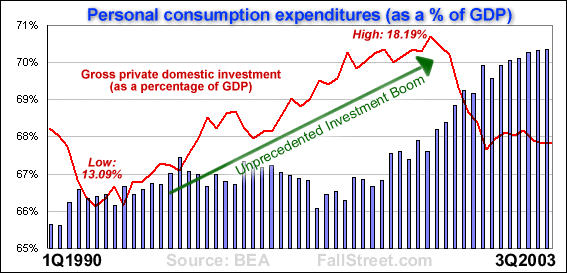 |
On the basis of the above chart, the obvious conclusion to be drawn is that consumers picked up the slack when overinvestment by companies went bust. Simple enough. However, when you dig into some of the specifics of the data a different ‘rebound’ trend emerges.
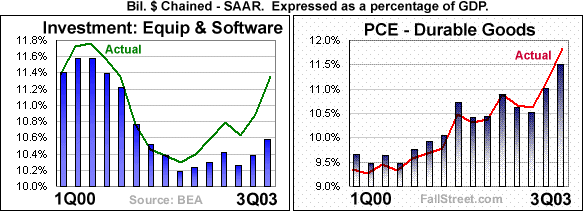 |
Notice the strong rebound in Equipment and Software investment – this increase in capital spending, combined with inventory rebuilding forecasts, is why many economists are arguing that the good times are here again. However, notice also how the durable goods component of PCE is soaring: it is almost as if the durable orders component of GDP ignored the recession completely.
Is this lack of a noticeable slowdown in the consumer backed components of GDP cause for concern? Perhaps. After all, using the overused but applicable example of automobiles, the consumers’ penchant for newly priced automobiles (there are more automobiles on the road than drivers) has gone a long way in supporting not only companies saddled with pension and earnings concerns but also the American economy. Domestic auto sales, just as inevitably as the build up in inventory levels, will surely slow in the coming years.
Another component of durables – furniture and equipment – also highlights the trend of potential overconsumption in spectacular fashion. Notice how growth in the 1990s – growth that is still continuing today – outpaced historical longer-term growth rates. Notice also how no dip in this component of durables has occurred in more than a decade.
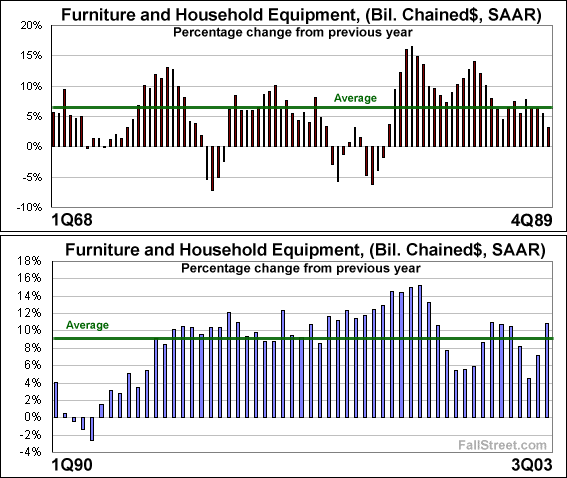 |
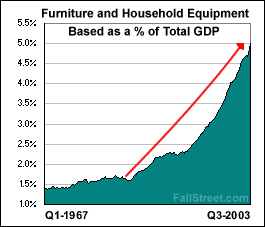 Of course these charts do not forecast that consumer spending is about to fall off a cliff (such forecasts are more easily concocted by pointing to escalating consumer debt levels and the weak jobs market.) Rather, the U.S. consumer has proven resilient since 2000, and there is no reason to believe that conspicuous consumption will end in America in favor of increased savings. What may end, however, is the consumer’s penchant to purchase more items as prices fall, and this, in turn, could impact overall spending levels.
Of course these charts do not forecast that consumer spending is about to fall off a cliff (such forecasts are more easily concocted by pointing to escalating consumer debt levels and the weak jobs market.) Rather, the U.S. consumer has proven resilient since 2000, and there is no reason to believe that conspicuous consumption will end in America in favor of increased savings. What may end, however, is the consumer’s penchant to purchase more items as prices fall, and this, in turn, could impact overall spending levels. With the price slashing/zero interest rate example of autos readily known, consider a household furnishings chart (to go along with the above charts). The revelation, after discovering that the consumer has been spending a greater aggregate sum on furnishings, is the price they have each been paying for these items. As with autos and apparels, lower prices are the norm.
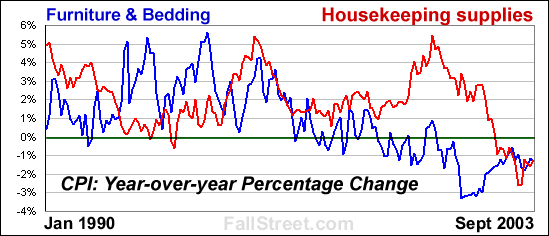 |
In sum, it stands to reason that with trillions in refinancing activity potentially being lost if interest rates continue to trend higher, that a significant pickup in capital spending and inventory rebuilding will be needed to counterbalance the inevitable slowdown in consumer spending. The hope in 2001 was that Bush’s $300+ billion infusion of cash would be spent by consumers and that this money would spur companies to increase their capital investments. Although these hopes did not come to pass in 2001, such an outcome is seemingly transpiring today: an estimated $83 billion of the $100 billion in tax checks was spent by consumers in 3Q03, a quarter when the refi boom seemingly reached its peak – capital spending continues to rise.
Transferring greater control for the growth dynamics of the U.S. economy away from consumers and towards industry is both logical and necessary for any semblance of a sustainable rally to unfold. Nevertheless, the point to remember is that companies seeking increased rates of profitability need not only increased productivity, but strong demand to enable price stability. That consumer demand could weaken just as companies begin to spend may not bode well for the U.S. economy in the future….
Such is why the employment reports are so significant: if jobs are being created this may afford consumers more purchasing power. Whether or not jobs will increase substantially given overcapacity and consumer spending concerns remains to be seen. Bush certainly hopes so.
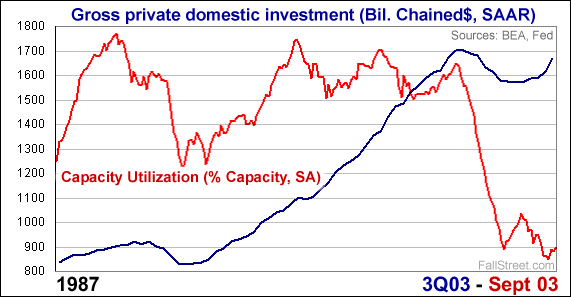 |
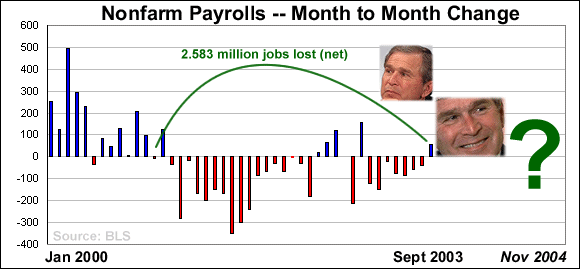 |
a